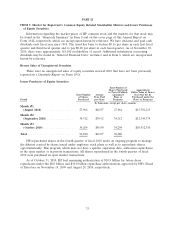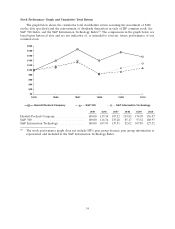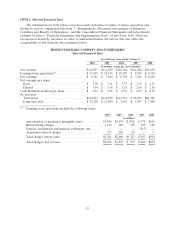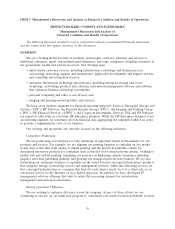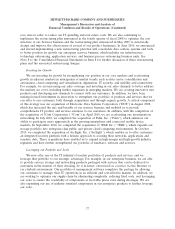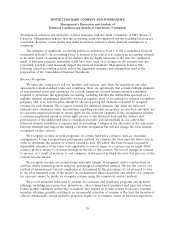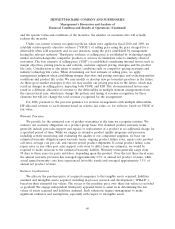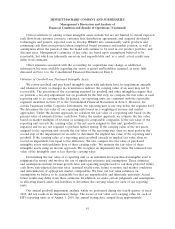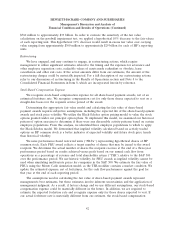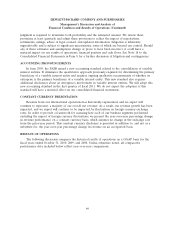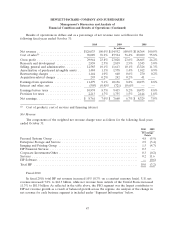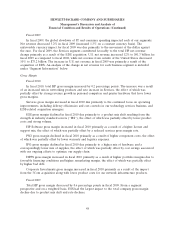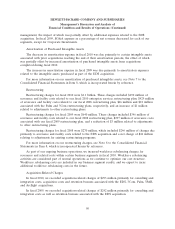HP 2010 Annual Report Download - page 48
Download and view the complete annual report
Please find page 48 of the 2010 HP annual report below. You can navigate through the pages in the report by either clicking on the pages listed below, or by using the keyword search tool below to find specific information within the annual report.HEWLETT-PACKARD COMPANY AND SUBSIDIARIES
Management’s Discussion and Analysis of
Financial Condition and Results of Operations (Continued)
and the specific terms and conditions of the incentive, the number of customers who will actually
redeem the incentive.
Under our current revenue recognition policies, which were applied in fiscal 2010 and 2009, we
establish vendor-specific objective evidence (‘‘VSOE’’) of selling price using the price charged for a
deliverable when sold separately and, in rare instances, using the price established by management
having the relevant authority. Third-party evidence of selling price is established by evaluating largely
similar and interchangeable competitor products or services in standalone sales to similarly situated
customers. The best estimate of selling price (‘‘ESP’’) is established considering internal factors such as
margin objectives, pricing practices and controls, customer segment pricing strategies and the product
life cycle. Consideration is also given to market conditions such as competitor pricing strategies and
industry technology life cycles. When determining our best estimate of selling price, we apply
management judgment when establishing margin objectives and pricing strategies and evaluating market
conditions and product life cycles. We may modify or develop new go-to-market practices in the future.
As these go-to-market strategies evolve, we may modify our pricing practices in the future, which may
result in changes in selling prices, impacting both VSOE and ESP. The aforementioned factors may
result in a different allocation of revenue to the deliverables in multiple element arrangements from
the current fiscal year, which may change the pattern and timing of revenue recognition for these
elements but will not change the total revenue recognized for the arrangement.
For 2008, pursuant to the previous guidance for revenue arrangements with multiple deliverables,
HP allocated revenue to each element based on relative fair value, or, for software, based on VSOE of
fair value.
Warranty Provision
We provide for the estimated cost of product warranties at the time we recognize revenue. We
evaluate our warranty obligations on a product group basis. Our standard product warranty terms
generally include post-sales support and repairs or replacement of a product at no additional charge for
a specified period of time. While we engage in extensive product quality programs and processes,
including actively monitoring and evaluating the quality of our component suppliers, we base our
estimated warranty obligation upon warranty terms, ongoing product failure rates, repair costs, product
call rates, average cost per call, and current period product shipments. If actual product failure rates,
repair rates or any other post sales support costs were to differ from our estimates, we would be
required to make revisions to the estimated warranty liability. Warranty terms generally range from
90 days to three years for parts and labor, depending upon the product. Over the last three fiscal years,
the annual warranty provision has averaged approximately 3.5% of annual net product revenue, while
actual annual warranty costs have experienced favorable trends and averaged approximately 3.3% of
annual net product revenue.
Business Combinations
We allocate the purchase price of acquired companies to the tangible assets acquired, liabilities
assumed and intangible assets acquired, including in-process research and development (‘‘IPR&D’’),
based on their estimated fair values. The excess of the purchase price over these fair values is recorded
as goodwill. We engage independent third-party appraisal firms to assist us in determining the fair
values of assets acquired and liabilities assumed. Such valuations require management to make
significant estimates and assumptions, especially with respect to intangible assets.
40





